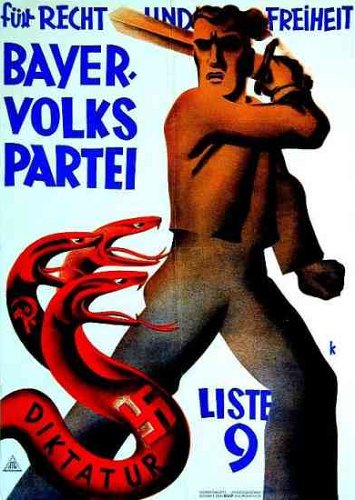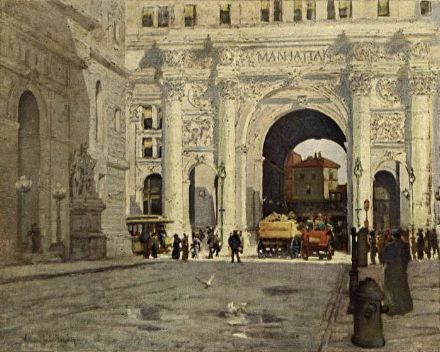World
About Andrew Cusack
 Writer, web designer, etc.; born in New York; educated in Argentina, Scotland, and South Africa; now based in London.
Writer, web designer, etc.; born in New York; educated in Argentina, Scotland, and South Africa; now based in London. read more
News
Blogs
Reviews & Periodicals
Arts & Design
World
France
Mitteleuropa
Knickerbockers
Argentina
The Levant
Africa
Cape of Good Hope
Netherlands
Scandinavia
Québec
India
Muscovy
Germany
Academica
Cousins

Nicholas II, Tsar of All the Russias and George V, the King Emperor.
Previously: Father & Son | Tennis, Anyone?
The Rosary Crusade
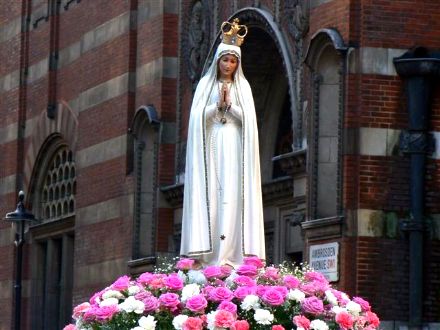
THE BLESSED VIRGIN HAS quite the legion of followers at her beck and call, and a good many battalions (perhaps even a regiment?) turned up on October 14 for the annual Rosary Crusade for the reparation of sins. The event began with a procession from Westminster Cathedral near Victoria Station, through the streets of London, to Brompton Oratory in Kensington. A statue of Our Lady was borne aloft by members of the Catholic Police Guild the whole way to the Oratory, where Benediction was held. We bring you these photos, taken by, amongst others, Matt Doyle, and Ken Simpson, all of which we found via ‘Joee Blogs‘, a Catholic medical student in London.
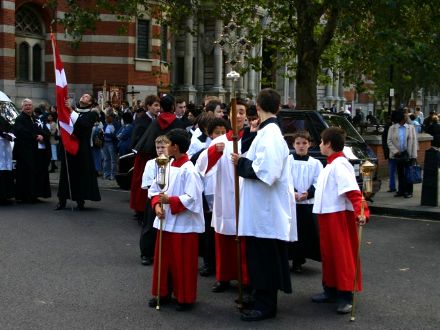
Poor Old Bram
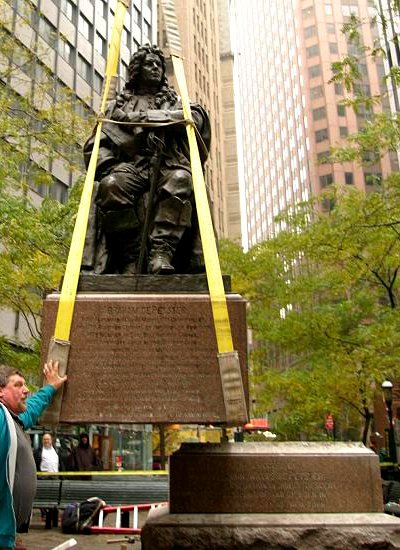
ONE HAS TO FEEL A certain amount of sympathy poor old Abraham de Peyster. The city fathers, in their infinite and unending wisdom, sought fit to erect a statue of Bram in Bowling Green, the old town square of New York down at the beginning of Broadway, many moons ago. However, having set Bram very nicely upon that green, the first public park in all New York, the city fathers have of late refused to let old Heer de Peyster rest. In 1972, the park was ‘renovated’ which entailed the statue’s forced removal. He ended up four years later in Hanover Square, a quite suitable though less prominent location, where he gazed across the square towards India House. It was then that old rivalries flared anew. (more…)
Our Holy Emperor
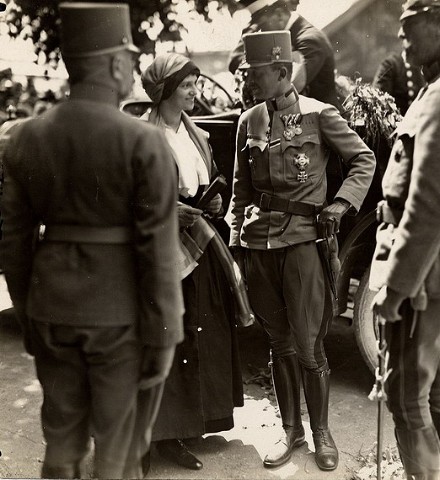
OCTOBER 21 IS the feast of Blessed Charles of Austria, the saintly emperor of that sacred realm whose life stands as an example of the price of sanctity. Charles worked tirelessly for peace both between the peoples of his own numerous realms and between all the nations, seeking to bring to an end the ceaseless and suicidal slaughter of the Great War, in the midst of which he had ascended to the throne of his fathers. A defender of social order, Charles reminds us of our many responsibilities to each other, even though the spirit of our current age would have us clamor only for our supposed rights. In the face of repeated betrayal and intense pressure, he refused to abdicate and so abandon his peoples to their fates, which were terrible indeed. That terrible cross he bore, the crown, was in fact a penitential grace, the sufferings he bore for the benefit of his – and indeed all – people. His reward was not in this world.
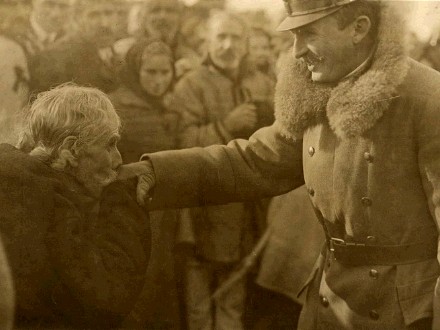
The Duke of York in New York
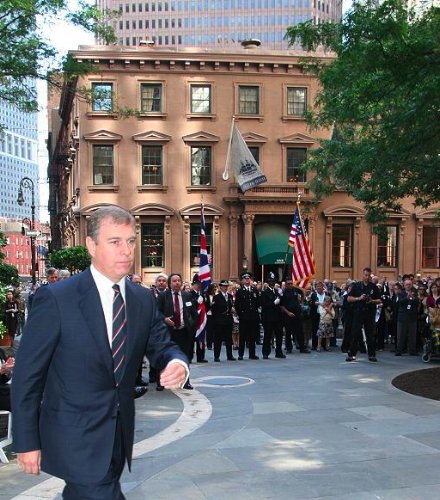
We neglected to mention Prince Andrew’s recent visit to New York in commemoration of the anniversary of the attacks on the World Trade Center. Sixty-seven British subjects died in the September 11, 2001 attacks, and eleven more were non-citizens with British ties. A ceremony was held in Hanover Square, where the British Memorial Garden is being built, followed by a reception at India House, which is located at No. 1 Hanover Square (the brown edifice in the photos above and below). (more…)
Lions and Torches and Trees (Oh My!)
Or, What £40,000 Gets You in Today’s World


A
MONG THE MANY changes which the Rt. Hon. David Cameron MP has wrought in his ten months as leader of the Conservatives one of the most public is the change of the party’s emblem. The flaming torch is out and the solid oak is in, at a cost of £40,000 to Conservative Central Office (according to the Times). There are three slightly different designs of the tree for the UK-wide, Scottish, and Welsh parties. Previously, the national party used the ‘flaming torch of liberty’ logo while the Scottish party used a blue lion rampant and Wales had its rather comely red-white-and-blue dragon with fire pouring forth from its mouth. The former logo was the ‘flaming torch of liberty’, which only entered into usage in the 1980’s under Mrs. Thatcher. In its place, we find instead an oak tree with healthy greenery on its limbs and a trunk made out in the traditional Tory blue. (more…)
James II, Our Catholic King
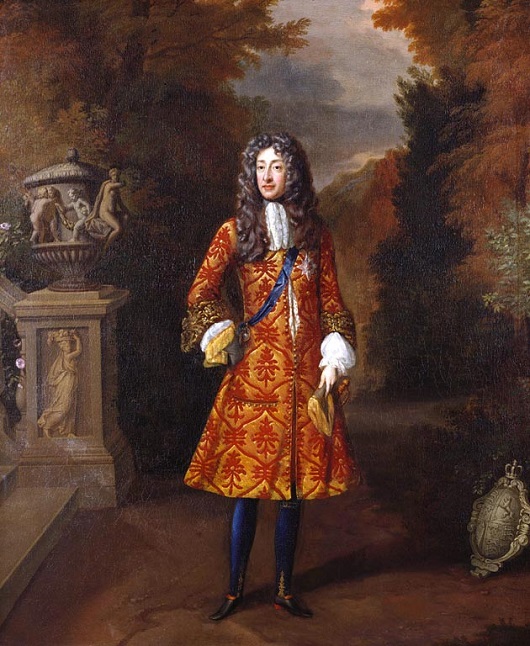
THIS PAST SATURDAY was the anniversary of the birth of King James II and VII of England and Scotland. The third son of Charles I, he was baptised into the Anglican church six weeks after his birth and was created Duke of York at eleven years of age. James married Anne Hyde, the daughter of the Earl of Clarendon, by whom he fathered eight children, though only two survived past childhood.
In 1664 the Duke of York equipped an expedition to relieve the Dutch of responsibility for their colonies in North America, and henceforth New Amsterdam and New Netherland were known as New York after their new Lord Proprietor.
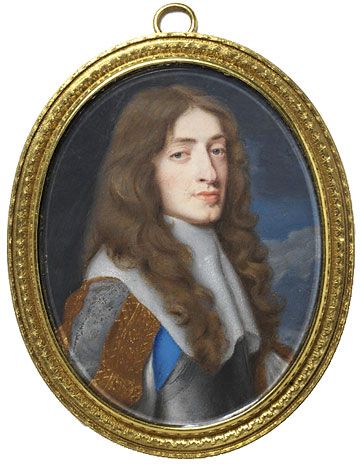
Sometime during the year 1670 both the Duke and Duchess of York were received into the Catholic Church and stopped attending Anglican services, though the conversion did not become public knowledge until the Test Act (requiring officeholders to receive communion in a Church of England service and take an oath against Transubstantiation) was passed three years later. James was forced to renounce his offices, such as Lord High Admiral of England, though not his titles. At any rate, Anne, the Duchess of York had died in 1671 only a year after her conversion. He married Princess Maria of Modena in 1673.
The Protestant oligarchs felt threatened by the prospect of a Catholic king and thrice tried to pass laws barring James from succeeding to the throne. However his elder brother Charles II, the reigning king, dissolved parliament each time before the bill was to be passed. King Charles II died in February 1685, (having reconciled himself to the Catholic faith before his end) and thus the Duke of York was proclaimed James II of England and VII of Scotland. A private Catholic coronation was held at Whitehall Palace on April 22 before the public coronation the following day on the feast of Saint George, which was performed according to the rites of the Church of England.
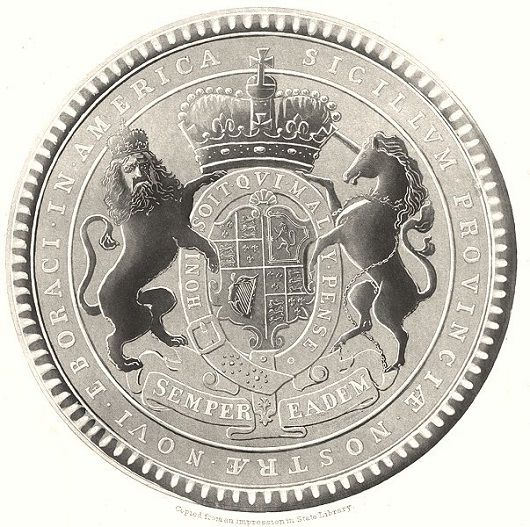
James had appointed the Catholic Thomas Dongan
as Governor of New York in 1682.
The Protestant oligarchs’ fears that James would end their hegemonic grip on Scotland and England proved well-founded as in 1687 he issued a Declaration of Toleration as King of Scotland, allowing Catholics, Episcopalians, and other non-Presbyterians to hold public office and the right of public worship, and a Declaration of Indulgence as King of England removing the laws penalizing non-attendance or non-communion at Church of England services, permitting non-Anglican worship in private homes or chapels, and abolishing religious oaths for public offices. Furthermore, James had allowed Catholics to hold positions at the University of Oxford for the first time since the Protestant Revolution. More provocatively, he tried to transform Magdalen College Oxford into a Catholic seminary. He had already reckoned with the rebellion of the Duke of Monmouth who proclaimed himself king two years earlier but had been captured, tried, and executed for treason. With the birth of a Catholic son and heir, Prince James Francis Edward, in 1688 a cabal of seven Protestant nobles issued an invitation to William of Orange, the Protestant Stadtholder of the Netherlands. A few months later, William of Orange duly arrived and usurped the throne, having already married James’ daughter Mary from his first marriage. The two ruled jointly as William and Mary.
Unwilling to create a popular martyr as had happened with the executed Charles I, William allowed James to escape and fled to France where Louis XIV gave the exiled monarch the use of a palace and an ample pension. James was intent on returning to his birthright, however, and took advantage of the Irish parliament’s refusal to recognise William’s usurpation of the throne. The King landed in Ireland in March of 1689 at the head of a Franco-Irish army but was defeated by William in the famous Battle of the Boyne in July 1690, and returned to his place of exile in France.
There, Louis allowed him to live in the château of Saint-Germain-en-Laye and offered to get James elected King of Poland but James felt this would prevent any chance of a Stuart again holding the throne of England. From that time onwards, James led a simple life of penance in reparation for his sins (he had had a number of mistresses in his younger days) and finally died in 1701. He was entombed in the Chapel of St. Edmund within the English Benedictine church on the Rue St. Jacques in Paris, while his brain was sent to the Scots College in Rome, his heart to the Visitandine Convent at Chaillot, and his bowels divided between the College of St. Omer (the exiled English Catholic school, now Stonyhurst in Lancashire), and the nearby parish church of St. Germain where they remained until they were desecrated by a Revolutionary mob and lost forever. His monument at Saint-Germain, however, was rediscovered in 1824 and is proudly displayed there to this day. There is also a monument to James and the Stuarts in St. Peter’s Basilica in Rome (c.f. Roma – Caput Mundi).
Aside from the pious tradition that Edward VII was received into the Church on his deathbed, James II was the last Catholic king (and as good King Edward never reigned over New York, James is even more certifiably so for us). There is a lovely coronation ode to James which I just might bring to your attention someday. But for now, reflect and remember our monarchs of old and pray that God in His mercy might grant us good Catholic rulers in stead of the shabby lot we elect today.
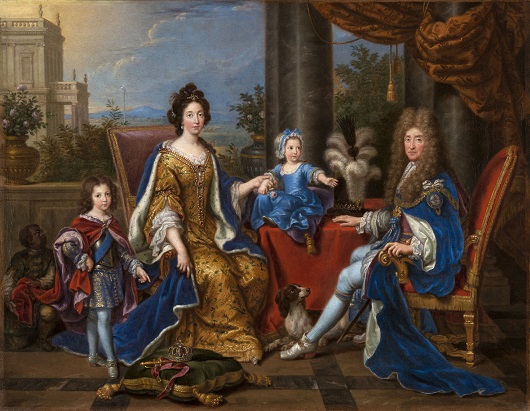
Old Dutch Gable
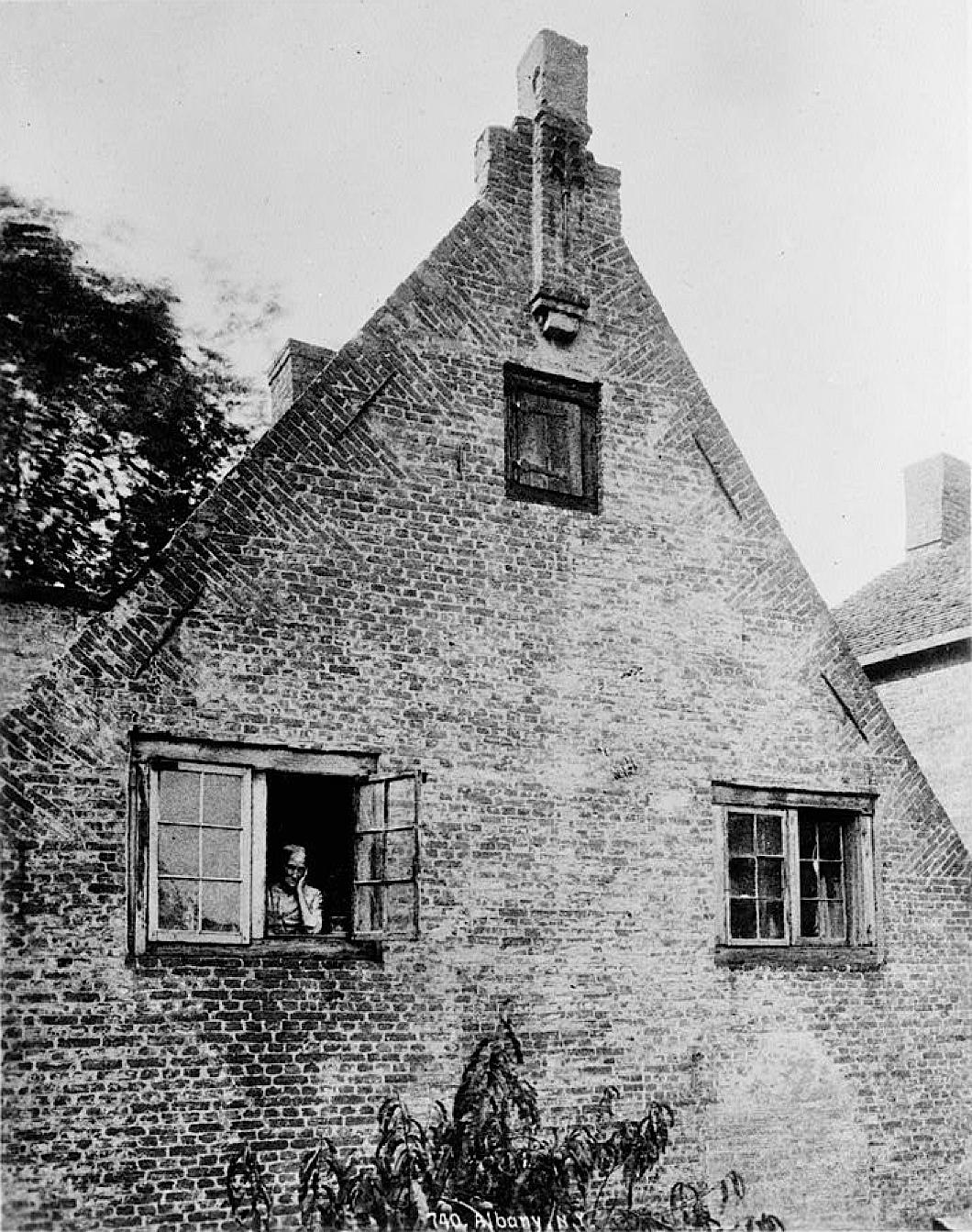
An old Dutch gable complete with old Dutch vrouw gazing miserably from the window. Albany County, New York, 1930’s.
The form of brick course on the gable is known as ‘mouse-tooth’ and is found primarily in Holland, East Anglia, and the Hudson Valley of New York, though also here and there in the American South.
The Auld Scotsman
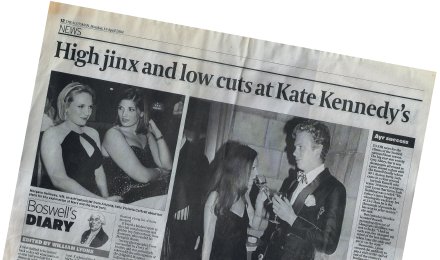
ONE THING WE greatly enjoyed about the Scotsman in its pre-tabloid days was that they often deemed St Andrews social events worthy of coverage in their august pages. It was a source of pride to see ‘the national newspaper’, a respectable broadsheet, covering events at the oldest university in the land (which we are proud to call our own). Naturally, once the conversion to tabloid size was complete, we were rarely heard of again, which was a little saddening. The Scotsman is not what it used to be —a beautiful, well-designed, informative respectable newspaper— but it still manages to print some thoroughly worthwhile articles which is more than can be said of any other Scottish daily. (One need only point out two articles by Prof. Haldane, c.f. here and here, recently posted on this site).
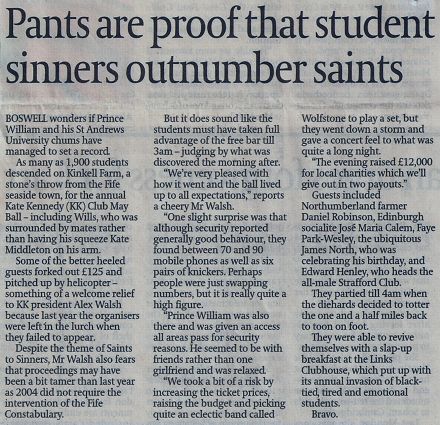
“…when the diehards decided to totter the one and a half miles back to toon on foot.” Sounds familiar.
Admittedly, most of the events covered were organised by the Kate Kennedy Club, which seems to take pride in the sheer vulgarity and tastelessness with which they advertise many of their events. (This is only slightly mitigated by their superb running of the annual Kate Kennedy Procession). Still, we enjoyed the Scotsman‘s coverage and wish it had continued. I only bought the Scotsman on occasion after the switch, but often gave the Common Room’s copy a browse when I lived in St. Salvator’s. (Its Sunday edition, Scotland on Sunday is worth buying for Gerald Warner alone).
Here are a few bits and pieces clipped from the Scotsman for your perusal:
‘Undampened spirits take the party indoors‘ / Lumsden Club garden party moved indoors on account of the rain. (I didn’t go).
‘High jinks and low cuts at Kate Kennedy’s‘ / This covered the Kate Kennedy Procession dinner which takes place at the Old Course Hotel on the evening following the procession. This particular year I was in attendance myself and recall commiserating with Michelle Romero, that charming daughter of Venezuela, about the troubled state of her native land. I was their with our favorite Dane, Sofie von Hauch, and my flatmate, a member of the KK who wishes to remain unnamed on this site. Will Lyons couldn’t make the dinner himself, so he sent ‘K‘ up instead, accompanied by ‘society photographer Z‘ whom I ran into while we were on our way out.
‘Maltesers set ball rolling for charity‘ / The 2004 Knights of Malta Ball, not covered by this website because it did not exist at the time. It was a good time, especially so because I had three friends over from the States. Yalie Adam Brenner was doing his semester abroad at St Andrews at the time, and fellow Old Thorntonian Clara de Soto popped over from Boston College for the weekend with her good friend Katie Cordtz of Atlanta. The four of us together with Michelle Romero and the aforementioned unnamed flatmate of mine piled into a cab and made the hour’s journey to Edinburgh for the soirée. Poor Adam, though. Towards the latter part of the evening Archie Crichton-Stuart, an exceptionally amusing Edinburgh student, and his friend Ramsay forced Adam to consume the significant remnants of a bottle of house red. It all went down swimmingly, but came back up on the cab ride back to Fife. Freddy McNair, who was recently nearly killed by an incompetent gurkha on a training ground, sat at the table next to ours, I recall. (Also, in the lower right-hand corner of the clipping you can spy the face of our good friend Ricky Demarco peering out from an unrelated article).
Previously: Another Broadsheet Bites the Dust
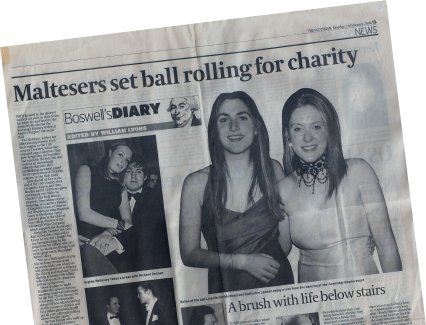
A Book to Remember
Chumley’s Launch Party for ‘Forgotten New York’ Book
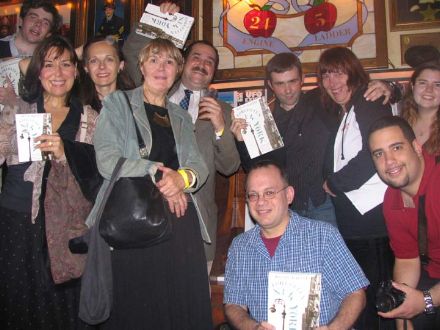
AS I GROW more and more cantankerous, my tolerance for evening trips down to Mannahatta declines, but on occasion there’s an event which would be a crime to miss. Last Thursday, Dawn Eden and I popped down to Chumley’s, the old speakeasy on Bedford Street in the West Village, for the shindig launching Kevin Walsh’s brilliant book, Forgotten New York: Views of a Lost Metropolis. (Kevin reports on the party here). I’ve been following Kevin’s Forgotten New York website for years now, and it has earned an unquestionable rank as one of my favorite sites ever (though, shamefully, I’ve never been on one of his legendary ‘Forgottentours’). The author himself was on hand, naturally, and I also enjoyed meeting a number of very kind people who are as fond of Forgotten New York as I am.
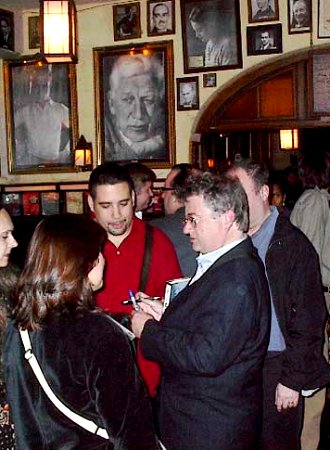
The Man of the Hour himself: Kevin Walsh (in glasses).
While Dawn and Kevin are familiar friends (she even gets a mention in the book’s acknowledgements), I had never before had the privilege of meeting this great chronicler of quinqueboronian miscellany. He is very much like his website: simple and brilliant. Happily, I got my complementary copy of the book personally inscribed, though I quite presumptuously upbraided him for only mentioning Audubon Terrace in passing (c.f. FNY: ‘I Can’t Drive 155’) while I believe it is worth a Forgotten page of its own. (Naturally, I have a post slowly developing on Audubon Terrace, which I believe is one of the most beautiful public spaces in all New York, as well as one of the most underappreciated).
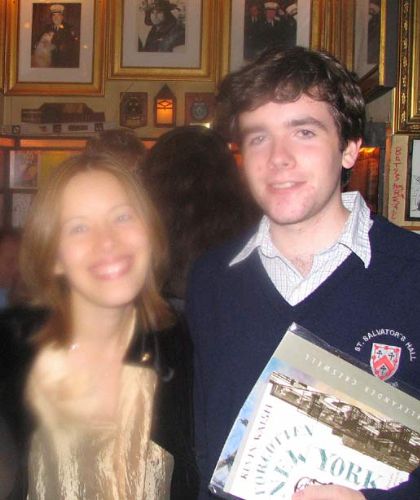
No, the camera isn’t smudged; an angelic haze follows Dawn wherever she goes.
But enough of the fun, how’s the book? Well I love it. It’s emphasis is on breadth rather than depth, since it’d be impossible to reproduce the entire contents of the encyclopedic website in a mid-sized paperback book. I view the book in two regards: first, as a handy basic guide referencing the variety of forgotten, unnoticed, and underappreciated sites around the Five Boroughs; and second, as a good jump-start companion to the more thoroughly informative website.
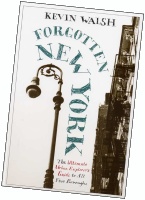
Take, for example, the Lent Riker Smith House out in Queens. Browsing through the book we see the entry on the ‘Lent Riker Smith Homestead’ which gives us two paragraphs of information. Enough to whet the appitite and plant the seed of intrigue, but when we check out the website’s entry on the house we get much, much more… and in color, to boot. I hope readers not yet familiar with the website will use the book as a springboard, but I also hope that we will be gifted with updated editions of the book in years to come, with added features.
Buy the book. Aficionados of forgotten-ny.com will appreciate a version of the familiar in dead-tree form, while the uninitiated will find it extremely useful as a foundation for appreciating Gotham’s numerous nooks and crannies. Kevin Walsh has done a great service to all those who have a love for the Big Apple.
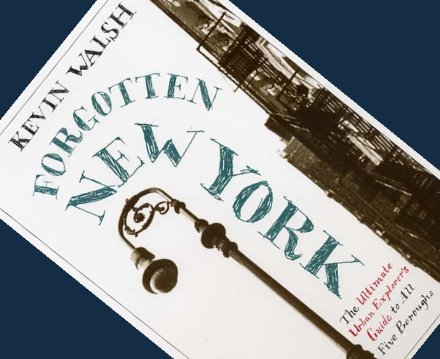
Birds of a Feather?
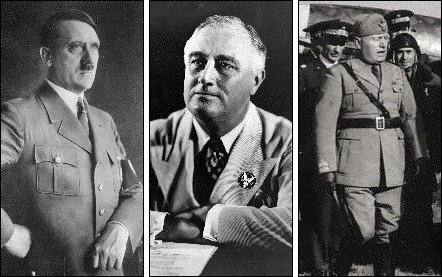
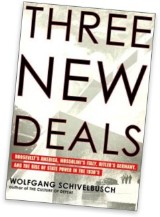 Were Hitler, Roosevelt, and Mussolini really just different cuts of the same cloth? In a new book, Three New Deals: Reflections on Roosevelt’s America, Mussolini’s Italy, and Hitler’s Germany, 1933-1939, Wolfgang Schivelbusch makes precisely that argument. Interestingly, the National Socialists in Germany looked with fondness towards Roosevelt’s style of rule. The Nazi party newspaper Völkischer Beobachter actually praised “the adoption of National Socialist strains of thought in his economic and social policies” while Mussolini also saw a bit of himself in FDR. Roosevelt wouldn’t give the time of day to Herr Hitler but was actually quite fond of Signor Mussolini, calling him “that admirable Italian gentleman”.
Were Hitler, Roosevelt, and Mussolini really just different cuts of the same cloth? In a new book, Three New Deals: Reflections on Roosevelt’s America, Mussolini’s Italy, and Hitler’s Germany, 1933-1939, Wolfgang Schivelbusch makes precisely that argument. Interestingly, the National Socialists in Germany looked with fondness towards Roosevelt’s style of rule. The Nazi party newspaper Völkischer Beobachter actually praised “the adoption of National Socialist strains of thought in his economic and social policies” while Mussolini also saw a bit of himself in FDR. Roosevelt wouldn’t give the time of day to Herr Hitler but was actually quite fond of Signor Mussolini, calling him “that admirable Italian gentleman”.
That there were massive differences between the three is obvious. (Mussolini and Hitler came to the brink of war over Austria, and later they both had a war with Roosevelt). Nonetheless, the similarities are worth pointing out, and David Gordon has written a review of the book over at the Ludwig von Mises Institute. Give it a read.
Heraldry is as much part of the future as present
by JOHN HALDANE
THE SCOTSMAN | Saturday 9 September 2006
A COUPLE of weeks ago St Andrews was treated to the sight of a colourful parade of heralds, hereditary standard bearers, nobility and clan chiefs, representatives of the University, leaders of the Christian churches, and sundry others, processing through the town to the accompaniment of the pipes. The occasion was the opening by the Princess Royal of the 27th International Congress of Genealogical and Heraldic Sciences, featuring the first meeting of European heralds since the middle ages.
This weekend St Andrews sees another ritual procession: this of Knights and Dames of the Equestrian Order of the Holy Sepulchre gathering for an investiture in the 15th century chapel of St Salvator’s College. Once again gowns, insignia, and banners of medieval inspiration will be on view as Scottish members are joined by representatives from abroad and from the Sovereign Military Order of St John – with the pipes again adding a distinctively Caledonian note.
Such events, and the groups and individuals they bring together can easily be seen as part of a world of childlike, or even childish, fantasy. Trying to live as if in a realm of castles, chivalarous knights, noble heroes, fair ladies, courtly love and sacred adventures, all rendered for posterity in chronicles and ballads.
The Old Police Headquarters
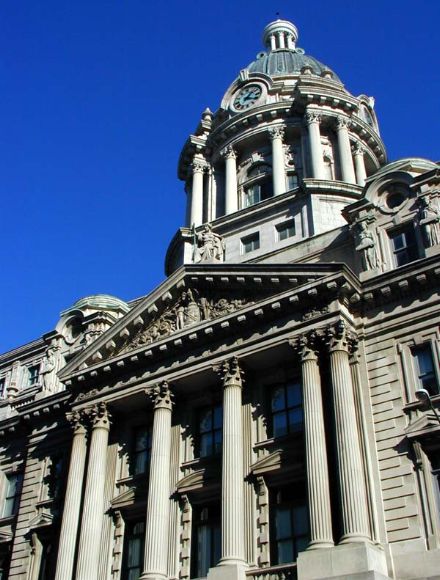
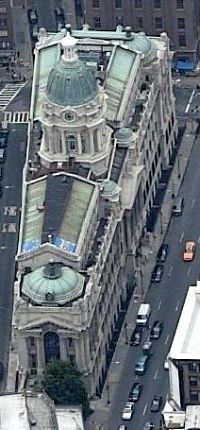 ONE OF THE finest buildings in all New York is also one of the least-appreciated and most forgotten. The old Police Headquarters at No. 240 Centre Street was built in 1909 on a triangular lot in what was then solidly Little Italy. Arguably, it is today located in the ever-expanding Chinatown, but real estate brokers usually describe its location non-ethnically as Soho, just on the cusp of the area which is increasingly (and most irritatingly) known as NoLIta, ‘North of Little Italy’.
ONE OF THE finest buildings in all New York is also one of the least-appreciated and most forgotten. The old Police Headquarters at No. 240 Centre Street was built in 1909 on a triangular lot in what was then solidly Little Italy. Arguably, it is today located in the ever-expanding Chinatown, but real estate brokers usually describe its location non-ethnically as Soho, just on the cusp of the area which is increasingly (and most irritatingly) known as NoLIta, ‘North of Little Italy’.
From the basement shooting range to the rooftop observation deck, the building was designed in the monumental Beaux-Arts style by the firm of Hoppin & Koen, “to impress both the officer and the prisoner with the majesty of the law.” The New York Times wrote that “its grandeur contrasted utterly with the little buildings and crooked streets around it.”
The older old Police Headquarters, where reformer Teddy Roosevelt held court as Police Commissioner, was located nearby on Mulberry Street and when the nerve center of the N.Y.P.D. shifted to Centre St. between Broome and Grand, the gun shops, cop saloons, and police reporters followed suit. One restaurant across the street was simply called ‘Headquarters’. With its oak bar and ceiling of carved wood, the ‘Headquarters’ restaurant became a particular favourite among the higher brass of the N.Y.P.D. According to popular lore, a tunnel was actually constructed connecting the restaurant with the actualy Police HQ, in which a number of the Boys in Blue used to enjoy a drink during the trying days of Prohibition. (more…)
Vienna on 43rd Street
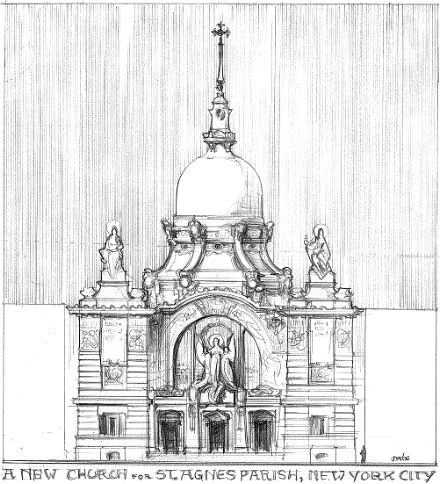
A WEEK AGO AFTER the 11 o’clock Sunday Mass at St. Agnes, Dino Marcantonio, Matt Alderman, and I stood in front of the church and fantasized about how we would fix the old place. Well, perhaps ‘old’ isn’t the right word for the place. While the parish was founded in the 1840’s, the current church building only dates from the late 1990’s, built after the old Victorian edifice was consumed by fire. As for design, its heart is in the right place, but as they say the Devil is in the details. The interior is marred by quite obviously large joints between component parts of arches and cornices and the exterior just looks fake. Is craftsmanship dead? No, but it helps to search it out instead of accepting just any old thing.
At any rate, Matt Alderman has thrown together these esquisses of what his St Agnes would look like, and it’s all rather Austrian. (more…)
Centro Naval, Buenos Aires
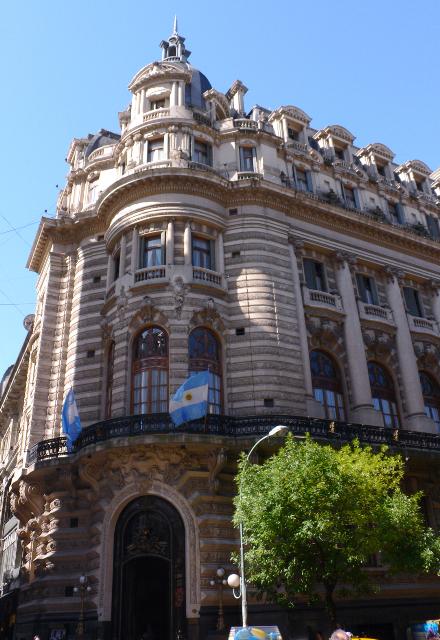
OUR GOOD FRIEND Tori Truett sends greetings from Buenos Aires where she is visting relatives and her salutation sparked a number of memories from my all-too-short time down there. One of these memories was being relieved upon by a bird whilst pottering about the market of San Telmo one afternoon (it remains the only time I have suffered the indignity of such an aerial bombardment). The good city, however, has more beautiful buildings than the Big Apple, both in quality and quantity. Their good buildings are better than ours, but then their ugly buildings are even uglier. (As terrible as the Whitney Museum is, I doubt it matches the Biblioteca Nacional for sheer vulgarity). (more…)
A Picture of Domestic Bliss
I work at my computer in a small room here at home, and Jamie has his in the main room alongside. When we are both tapping away busily, our work is punctuated by his pleas for cups of tea (sometimes he just makes a sort of bleating noise – it’s really quite heart-rending) and by the telephone ringing (annoying – so we often leave the answerphone on and deal with calls later). […]
Later, emerging from a tube station on my way to St Mary’s Church in Chelsea where I was due to give a talk to young engaged couples as part of a Marriage Preparation course, I had a most extraordinary and wonderful experience. There are eight million people in London. And there, walking towards me, was the one person dearest to me in all of them: my husband Jamie. He would never normally be in that part of London, and it is unusual for me to be there too. Neither of us had co-ordinated our activities today, just normal busy schedules for us both…….. He had been at some event at Brompton Oratory followed by lunch and a meeting nearby…..it was a chance in eight million that we should both happen to be in Sloane Square at that precise moment.
Just a little snippet from Joanna Bogle’s new blog, Auntie Joanna Writes. Joanna is an author and journalist, as well as being wife to Jamie Bogle (c.f. balls of ’05 and ’06). You can go on a tour of Catholic England by listening to fourteen of Joanna’s ‘Catholic Heritage’ programs available at this address.
The Heraldic Congress
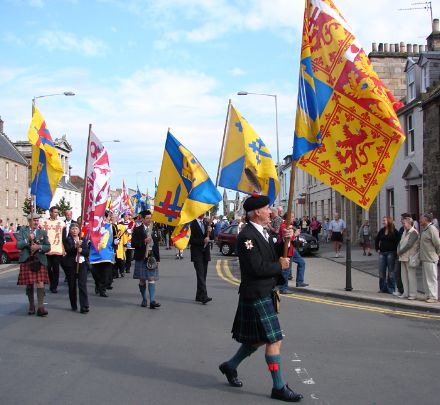
THE ROYAL BURGH of St Andrews was recently host to the largest gathering of heralds since the Middle Ages for the XXVII International Congress of Genealogical and Heraldic Sciences. Taking place in the last week of August, the Congress was opened with a grand ceremony in the University’s Younger Hall which was attended and addressed by the XXVII Congress’s patron, the Princess Royal (Scottish arms below). The event lured state heralds, genealogists, heraldists, and other enthusiasts from around the world, as well as local heralds from the Court of Lord Lyon (Scotland’s heraldic authority) and the personal heralds of Scots noble houses. Aside from the ceremonial, a broad variety of lectures were given on various topics in the realm of heraldry and genealogy. We present to you here a number of photographs from the event, which have been taken from the Congress website as well as from the personal collections of Mr. John Gaylor, a member of the Heraldry Society of Scotland, and Mr. David Appleton of the American Heraldry Society.
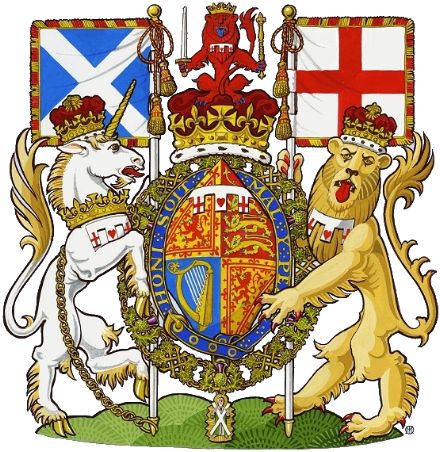
The Jefferson Guards
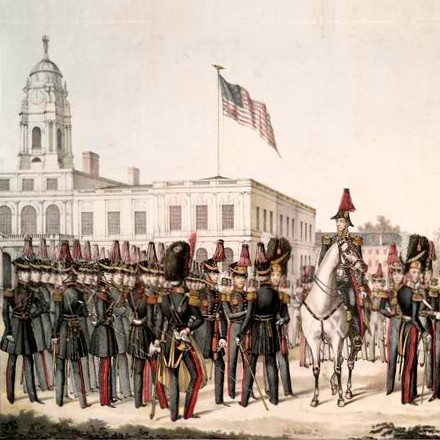
I recently stumbled upon this image depicting a militia regiment gathered in front of New York’s City Hall. The unit in question is the Jefferson Guards, 38th Regiment, New York State Artillery, amassed in bearskin caps and red-plumed shakos (red being the traditional color of the artillery). I confess I’d never heard of the Jefferson Guards before, but this is not entirely surprising. The Armed Forces of the State of New York – today composed of the New York Army National Guard, the New York Air National Guard, the New York Guard, and the New York Naval Militia – was once composed of a vast array of assorted regiments, battalions, and companies (a quite literal example of the ‘little platoons’ praised by Burke). These militia companies varied greatly in form, from little more than glorified social clubs to the crack units of the day.
As strange as it may seem, considered as a whole they were an almost completely organic military and, while they would be ill-suited to the armed exigencies of today, I refuse to believe that our little realm is better off for their general disappearance. Certainly the V.C.A. and the Old Guard, among others, survive to this day (in a somewhat different form, naturally), but what of the Empire Light Cavalry and the German Horse Guards? The Ulster Guard, the Weschester Chasseurs, and the New York Highlanders? The gallant Seventh Regiment of New York survived even into the 1990’s before its dissolution was ensured by the monotony monitors who now, fifteen years later, seek to destroy the great and blessed monument of an armory on Park Avenue which the Seventh built and guarded for over a century. We mourn their disappearance, just as we detest the continued and increasing disdain for the proud military heritage of the City and State of New York, but the entire culture which created and sustained them is gone, too.
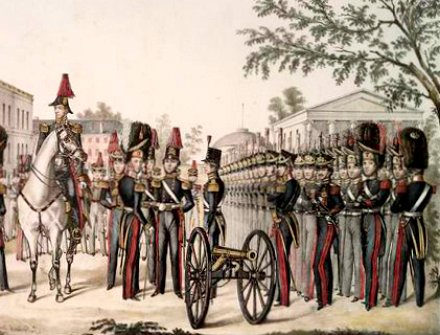
Category: Militaria – New York
Search
Instagram: @andcusack
Click here for my Instagram photos.Most Recent Posts
- Amsterdam November 26, 2024
- Silver Jubilee November 21, 2024
- Articles of Note: 11 November 2024 November 11, 2024
- Why do you read? November 5, 2024
- India November 4, 2024
Most Recent Comments
Book Wishlist
Monthly Archives
Categories

